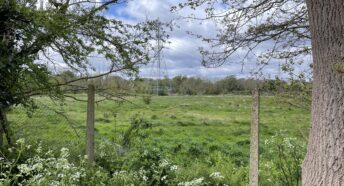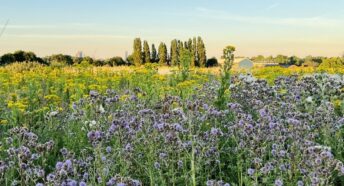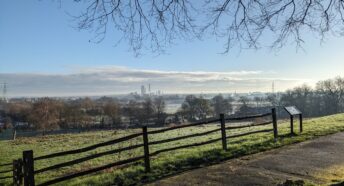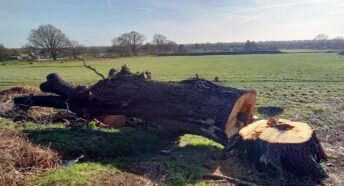Nowhere safe: 50 London parks and green spaces under threat
MEDIA RELEASE
NO LONDON PARK OR GREEN SPACE SAFE FROM DEVELOPMENT
More than 50 London parks and green spaces under threat from privatisation and neglect: even premier league clubs Spurs and West Ham ‘in on the act’, say campaigners
Environment campaigners CPRE London have today released a new report Forever Green March 2022 identifying more than fifty parks and green spaces under threat from development in London and, as the local elections approach, they are calling for borough councils to take action.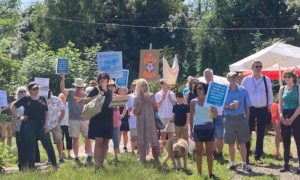
Alice Roberts, Head of Campaigns at CPRE London said: “Nothing is safe: all kinds of green space – from public parks, including historic and even royal parks, to vast areas of Green Belt, sports pitches, recreation grounds, open fields, nature reserves and green spaces in housing estates – are coming under threat. Many of the sites have protected Green Belt and Metropolitan Open Land status.
“Developers and borough councils are often behind the threats. And even Premier League football clubs Spurs and West Ham [EXAMPLE 3] are in on the act, looking to profit from deals with councils – Spurs to build a training facility on Whitewebbs Park in Enfield, West Ham to build a new development centre, kicking out grass roots football club Bealonians’ from playing fields in Redbridge.
“This situation is extremely alarming. London only has half the green space it needs for a population its size[3] and the limited green spaces we have are coming under more pressure since the start of the pandemic despite their growing importance.[4] Meanwhile, attacks on Green Belt threaten loss of countryside around London while leaving rundown brownfield sites unused.
“Threats nearly always relate to money one way or another because land is worth much more if it can be developed. This is exacerbated because there is currently no mechanism that provides robust legal protection for parks and open spaces in London.
“The planning system doesn’t seem provide adequate protection anymore either. Despite welcome policies in the London Plan [5] and positive action by some Boroughs [6], the national reforms in 2012 have opened the system up to greater challenge, so if you can argue that building on a green space is ‘sustainable development’ then that seems to trump all protections. Obviously that is arguable but it just creates a bonanza for lawyers and puts the party able to pay for legal support in the strongest position.
“As a result the protection of London’s green spaces ultimately falls to local communities who are prepared to fight for them. Often they don’t have the necessary expertise or resources. Even so, there are many local groups prepared to campaign – and we, and others like the London Gardens Trust, help them as far as we can.”
Alice Roberts concluded:
“Urgent action is needed to address these growing threats. We now want all those standing for election to Borough Councils to commit actively to identify green spaces under threat; and positively plan, with local groups, to save those spaces. Where a borough council is actively involved in creating a threat, we are urging them to think again.
“Ultimately, we need effective legal and planning policy protection for our precious green spaces. That may well mean new legislation and changes to the National Planning Policy Framework. Until effective protections are in place – your local park is only as safe as the communities who befriend it and are prepared to fight for it.”
EXAMPLES AND QUOTES
- More details of each case in Section C of the report
- Contact details / photos available on request
1. ENFIELD GREEN BELT (Enfield)
Alice Roberts of CPRE London “Enfield and Hounslow councils want to release huge areas of Green Belt for development, including historic Enfield Chase, despite plentiful availability of brownfield land.”
Carol Fisk, Enfield RoadWatch “The Council’s proposals to build up to 12,000 homes on the Green Belt would change the character and degrade the environment of Enfield forever, without solving the borough’s affordable housing needs, which can be addressed on far more suitable brownfield sites. The proposals are short-sighted and detrimental to the health and welfare of the borough’s residents, many of whom object to the plan.”
2. QUAGGY FIELDS SPORTS GROUNDS (Greenwich)
Alice Roberts of CPRE London “Developers are buying up land, particularly playing fields, fencing them off and leaving them to become derelict, so they can apply for planning permission down the line.”
Catherine Ashcroft, local campaigner “We’re really worried about playing fields between Lee and Kidbrooke which have been bought by developers and fenced off. The owners have removed public access and made it impossible to book them for training or matches. They hope the council and local people forget they’re important public sports amenity spaces, with a view to gaining planning permission to make huge sums of money through future development of land that was put in trust for public use. We’ve already lost one field so we’re now fighting for the other sites to be brought back into public use.”
3. OAKFIELD SPORTS GROUND (Redbridge) AND WHITEWEBBS PARK (Enfield)
Alice Roberts of CPRE London “Premiership clubs Spurs and West Ham are looking to profit from deals with local councils – Spurs to build a training facility on Whitewebbs Park in Enfield, West Ham to build a new development centre, kicking out grass roots football club Bealonians from playing fields in Redbridge.” More details in the report.
Andy MacRae, General Secretary, Bealonians FC (07979 706456) “The popular grassroots club, Bealonians FC, is at risk of losing its current home at Oakfield Playing Fields, Barkingside, to make space for wealthy Premier League club West Ham United. Our lease discussions with London Borough of Redbridge were ceased and we understand they’re negotiating to use our site for West Ham’s Academy, effectively privatising a public amenity and kicking out an established local club, the largest in the borough, in favour of a Premier League club. Almost unbelievably, we’re now having to campaign to protect the site from private interests, despite running the type of local grassroots club which everyone recognises is hugely valuable for sport, health, wellbeing, community cohesion and much more.”
Sean Wilkinson, Friends of Whitewebbs Park “Enfield council is planning to lease a huge section of Whitewebbs Park to Tottenham Hotspur FC to build an extension to their football training ground. This parkland was bought for the people of Enfield to enjoy as open space, not as a cheap facility for a wealthy premier league corporation. THFC has no experience of running publicly accessible parks and has no interest in doing so. The process has been a disgrace with no meaningful public consultation and many broken promises. We’re sure the players and fans would be hugely embarrassed, particularly as we’re just emerging from a pandemic which has demonstrated the importance of public parks to public mental and physical health. The council should know better as the proposal directly opposes their stated policies on climate and biodiversity. While the ‘Lease’ is notionally for 25 years there is every possibility that this whole park it will be lost forever.. We’re fighting to save this space for future generations and expecting it to be a major issue for the upcoming local elections.”
4. WIMBLEDON PARK (Merton)
Alice Roberts of CPRE London: “Meanwhile, in Merton, the All England Lawn Tennis Club, which runs the Wimbledon Tournament, is making a bid to take over neighbouring Wimbledon Park.”
Iain Simpson, Chair Wimbledon Park Residents’ Association: “Precious Open Spaces like Wimbledon Park are the lungs of our great city; irreplaceable habitats for thousands of creatures; views and vistas appreciated and enjoyed by all. The AELTC’s proposals will destroy this with 8 years of building works to create an industrial tennis entertainment complex for the use of elite players 18/365 days, just 5% of the year. We are enormously grateful for CPRE’s support to ‘Save Wimbledon Park!’.”
5. WEST HAM PARK (Newham)
Alice Roberts of CPRE London: “The City of London Corporation, custodians of West Ham Park, are looking at selling off part of the park to pay for maintenance.”
Roger Jones, Friends of West Ham Park: “West Ham Park is a 77 acre Grade 2 green oasis in East London, hugely valued by the community it serves, but now the City of London want to build houses on part of the former plant nursery. This area could be used instead to enlarge the public area of the park which has been a lifeline both before and during the COVID pandemic in this densely crowded area. We want local communities to gain the most from this fabulous open space and are appalled at this proposal and intend to fight it.”
6. SOUTHWARK INFILLING (Southwark)
Alice Roberts of CPRE London “And councils under pressure to deliver housing are building ‘infill’ developments on housing estates green spaces all over London.”
Lewis Schaffer, local campaigner, Southwark: “Southwark Council is building on green spaces and play areas all over the borough, infilling with private and social housing. In these developments, the Council is both landowner, developer and local planning authority all rolled into one, so it does what it likes with minimum scrutiny or accountability. For years, Southwark has been selling estates off to developers for private housing, ignoring the Mayor’s 35% minimum social housing inclusion. Their approach is disrespectful and undemocratic.”
Campaigner quotes from other sites
WALDEN WOODS (Bromley)
“In 2016 we won protected status for this remnant of ancient woods, an area of importance of nature conservation including wet woodland and open scrub. We were delighted, even though we had to relinquish about 20% of the original area to Bromley Council for educational purposes. But Bromley Council has now decided the site is the only one in Bromley suitable for a much-needed SEN school and we are bitterly disappointed the proposal will mean loss of a further 10% of our open space. The decision was made without consultation or public notification, or recognition of its status as important habitat.” Barbara Arora, Chair, Friends of Chislehurst and Walden Recreation Grounds
CANAL CLUB COMMUNITY GARDEN (Tower Hamlets)
“Back in 2004 the area next to the canal had been sadly neglected and we were granted full planning permission to grow a wildlife community garden on the site. We opened the garden in 2010 and have been running public events outdoors ever since, as well as teaching using the garden to relate stories about our urban wildlife. Many of our visitors have never entered such a green wildlife space before. Unfortunately, this is now all under threat. It’s taken over eleven years to reach this stage to make a true example of a functioning wildlife garden and we hope now with legal aid on our side we may have a chance to continue”. Sally Hone, volunteer, Canal Club Community Garden
TOOTING COMMON (Wandsworth)
“Wandsworth Council is planning to fence off and charge for access to a section of Tooting Common as part of a new commercial football facility. The plans will lead to the enclosure of 38,500 square foot of land, fencing it off and commercialising a public space. The floodlighting and 15 foot high fence mean the proposals will also impact a much larger area of protected land.” Ben Jackson, local campaigner
NOTES
[1] CPRE London is a membership based charity with 2,500 members across London. We campaign to save London’s precious green spaces, Green Belt and Metropolitan Open Land and to work for a greener London.
[2] Link to report: Forever Green?
[3] Fields in Trust Green Spaces Index
[4] Polling in 2020 showed that nearly two-thirds (62%) of people think protecting and enhancing green spaces should be a higher priority after the lockdown.
[5] The London Plan was adopted by the Mayor of London in January 2021 and contains policies to protect Green Belt (G2) and Metropolitan Open Land (G3) although these need to be effectively applied.
[6] For example, Hackney is preparing a Green Infrastructure Strategy and Bromley has designated 25 Local Green Spaces in its Local Plan.




